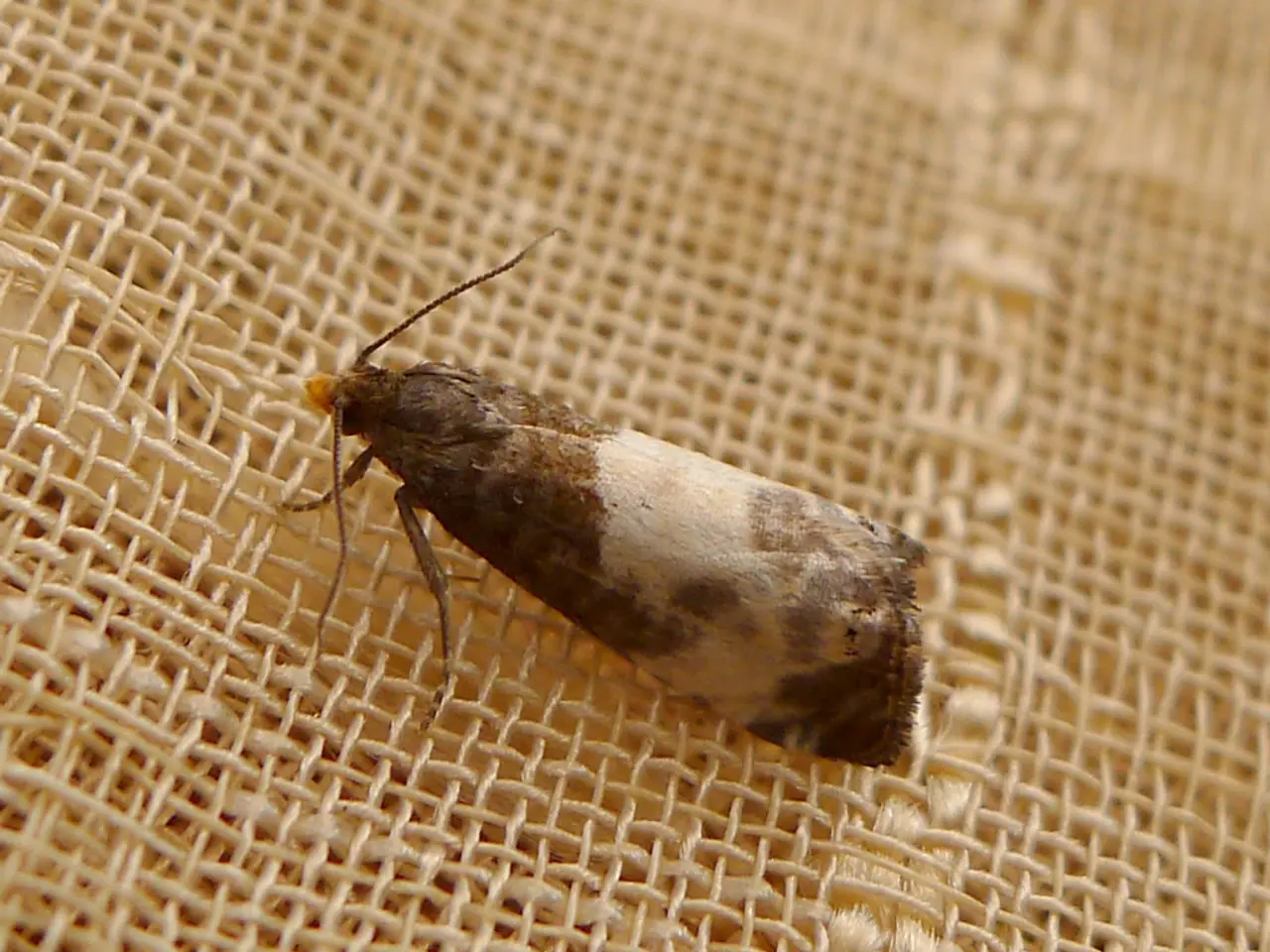Eliminating Moths: Top 10 Strategies for Success
Moths, often seen as harmless creatures, can pose a significant threat to our health and property. In the United States alone, there are nearly 11,000 species of moths, and some of these can be hazardous.
Moths can cause allergic reactions, particularly in sensitive individuals. Allergic reactions may present as skin irritation, rashes, eye irritation, throat discomfort, and symptoms similar to poison ivy. Exposure may lead to itching, blisters, swelling, sore throat, coughing, and, in some cases, fatigue or malaise [1][3][5].
The primary health risks, however, stem from certain species that have toxic or irritating hairs, such as the oak processionary moth (Thaumetopoea processionea) and the browntail moth (Euproctis chrysorrhoea). These larvae carry urticating hairs that can cause severe skin irritation, rashes, eye irritation, throat discomfort, and allergic reactions [1].
Clothes moth larvae, while not toxic, pose a different health and property risk by causing irreversible damage to fabrics, carpets, and leather. Infestations can also cause distress and require considerable effort to eliminate [2][4].
To effectively remove moths and their larvae from a home, the following methods are recommended:
- Identification and removal of infested items: Isolate and discard or treat affected textiles such as clothes, carpets, or furniture [2].
- Temperature treatments: Freezing infested clothes for several days kills eggs, larvae, and adult moths. Washing with hot water, dry cleaning, or steam ironing also eradicates larvae and eggs [2].
- Cleaning: Thorough vacuuming of cracks, crevices, and other potential hiding spots removes larvae residues or eggs [2].
- Use of insecticides: Natural insecticide sprays formulated for clothes moths can eliminate adults and larvae [2].
- Professional pest control: Considering moths with urticating hairs pose health risks, and clothes moth larvae cause fabric damage, professional pest control services are strongly advised especially for larger infestations or species like oak processionary moths. Professionals use appropriate, humane, and safe measures to fully eradicate the infestation and minimize health risks [4].
Prevention is key in managing moth infestations. Seal cracks and entry points, store textiles properly, maintain cleanliness, and inspect second-hand items before bringing them indoors can reduce the risk of infestations [4].
For those seeking natural remedies, cedar oil can be used as a replacement for cedarwood to repel moths. White vinegar can change the pH levels of surfaces, making it inhospitable for moth eggs and larvae. Moth traps are designed to trap and kill adult moths [6].
In summary, health risks from moth larvae mostly come from toxic caterpillars like oak processionary and browntail moth species, causing allergic and irritant reactions, which require careful handling and professional removal. Clothes moths mainly damage materials but still necessitate thorough cleaning and sometimes chemical treatments to control.
References: - Oak Processionary Moth larvae cause skin, eye, throat irritation due to toxic urticating hairs [1]. - Gypsy and browntail moth caterpillars cause allergic skin rashes and respiratory symptoms [3][5]. - Freezing, high heat treatment, insecticides, and cleaning are effective for clothes moth eradication [2]. - Professional pest control recommended, especially in case of large infestations and health risks [4]. - To prevent a moth infestation, carefully seal any clothes that will not be regularly worn in airtight bags, such as vacuum-seal storage bags [9]. - Cedar oil can be used as a replacement for cedarwood to repel moths [7]. - White vinegar can change the pH levels of surfaces, making it inhospitable for moth eggs and larvae [8]. - Moth traps are designed to trap and kill adult moths [6]. - Some less common symptoms of Lepidopterism include eye irritation, a sore throat, and breathing difficulties [3]. - Inhaling moth hairs can cause respiratory complications in people who are allergic [3]. - Moth larvae can damage clothing, other fabrics, and foodstuffs [2]. - There are approximately 160,000 species of moths globally [4].
- In addition to the health risks, some moth species can also pose a threat to our property by damaging fabrics, carpets, and leather.
- Certain species of moths, such as the oak processionary moth and the browntail moth, have toxic or irritating hairs that can lead to multiple symptoms including skin irritation, rashes, eye irritation, throat discomfort, allergic reactions, and in some cases, fatigue or malaise.
- Beyond the threat to health and property, moth larvae can also cause distress and require considerable effort to eliminate, as demonstrated by infestations of clothes moths.
- For those looking for an alternative to traditional methods, cedar oil can be used as a natural repellent to keep moths away from fabrics, carpets, and leather.
- Preventing moth infestations is essential, and steps such as sealing cracks, proper storage of textiles, maintaining cleanliness, and inspecting second-hand items before bringing them indoors can help to reduce the risk.
- In the fashion-and-beauty and home-and-garden sectors, it's important to pay attention to moth-related issues, as moths can damage clothes, other fabrics, and foodstuffs.
- Furthermore, research suggests that moth infestations could potentially impact cognitive functions, with studies linking moth exposure to symptoms of depression and Alzheimer's disease in some individuals.




